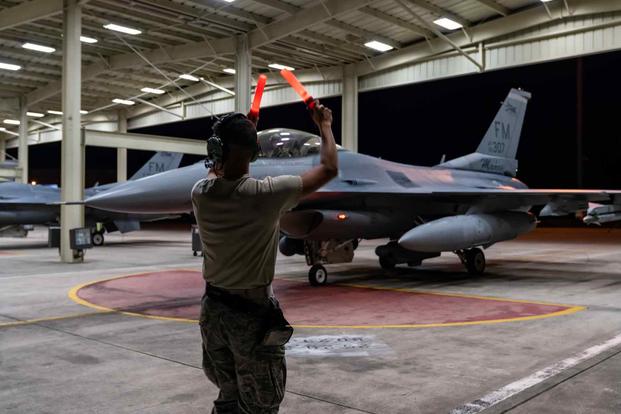The U.S. and its allies will begin training Ukrainians on F-16 Fighting Falcon fighter jets after months of lobbying and requests from Kyiv, the latest in the effort to help the Western-style democracy fend off a Russian invasion.
President Joe Biden broke the news to world leaders at the Group of Seven summit in Japan on Friday, according to a U.S. official with knowledge of the decision, and the move was hailed by the U.K. and Ukrainian President Volodymyr Zelenskyy on social media.
"The U.S. will support a joint effort with our allies and partners to train Ukrainian pilots on fourth-generation fighter aircraft, including F-16s, to further strengthen and improve the capabilities of the Ukrainian Air Force," the U.S. official told Military.com in an email.
U.K. Prime Minister Rishi Sunak praised the announcement in a tweet, saying his country "will work together with the USA and the Netherlands, Belgium and Denmark to get Ukraine the combat air capability it needs."
Zelenskyy said that he welcomed the "historic" decision and that it will "greatly enhance our army in the sky." The leader of Ukraine, known for his forceful stand against Russian President Vladimir Putin's onslaught and his signature olive drab outfits, was expected to participate in the meeting of leaders in Japan on Sunday, according to The Associated Press.
"I count on discussing the practical implementation of this decision at the G7 summit in Hiroshima," he added in a tweet.
The U.S. official said it would be up to the countries that are participating in the training to decide "when to actually provide jets, how many we will provide, and who will provide them."
Ukraine's interest in foreign fighter jets goes back months. In April, the country's Air Force tweeted about the idea, saying that its "greatest need is for fighter jets -- F-15s and F-16s of the fourth generation or higher would be sufficient."
Another Ukrainian Air Force official went so far as to rebuff the American idea of sending the older A-10 Warthog, telling Military.com that the planes would "not close our sky, they will not stop bombers and missiles."
In July, the U.S. Air Force's top officer, Gen. Charles "CQ" Brown, said that officials were, indeed, considering the training.
"I do believe that we have an aspect and a responsibility, like we do with all our allies and partners, to be prepared to train them in various capabilities and capacities," Brown told the Aspen Security Forum in Colorado.
Gen. Mark Milley, chairman of the Joint Chiefs, also said the possibility was being considered around the same time.
In March, NBC reported, citing two congressional officials and a senior U.S. official, that two Ukrainian pilots came to the U.S. to be tested to see how long it would take to train them to fly attack aircraft, including F-16 fighter jets.
However, experts who spoke to Military.com were skeptical that it would be a simple matter of just a few classes. One Air Force veteran pilot said supplying and training Ukrainians on the planes would be nothing short of a "herculean effort."
Gen. James Hecker, the head of U.S. Air Forces in Europe as well as Air Forces Africa and Allied Air Command, told Military.com in March that he's not surprised by the request for the modern jets but doubts the aircraft's ability to repel Moscow's invasion.
"I think it's going to help them a little bit," Hecker said. "I don't think it's going to be a game changer."
Those concerns were similar to the issues raised when the Ukrainians asked for another major U.S. weapons platform -- the Abrams tank.
Colin Kahl, the under secretary of defense for policy, told reporters in January that "the Abrams tank is a very complicated piece of equipment."
"It's expensive, it's hard to train on. ... It is not the easiest system to maintain," Kahl said at the time. "It may or may not be the right system."
There were also concerns about supplying the fuel-hungry gas turbine engines used to power the main battle tank.
A 1992 Government Accountability Office report found that, during the first Gulf War, "Abrams crews were impressed with the power and performance of the Abrams' turbine engine, but they were concerned about its high fuel consumption and the need to frequently clean air filters in the sandy desert environment.
"Refueling was a constant concern," the report added.
Despite these reservations, Ukrainian troops are set to start training on the tanks in Germany in the next couple of weeks, and the Pentagon aims to have 31 Abrams in the country by the fall.
-- Thomas Novelly contributed to this report.
-- Konstantin Toropin can be reached at konstantin.toropin@military.com. Follow him on Twitter @ktoropin.
Related: Abrams Tanks Arrive in Germany, Setting Stage for Ukrainian Training












